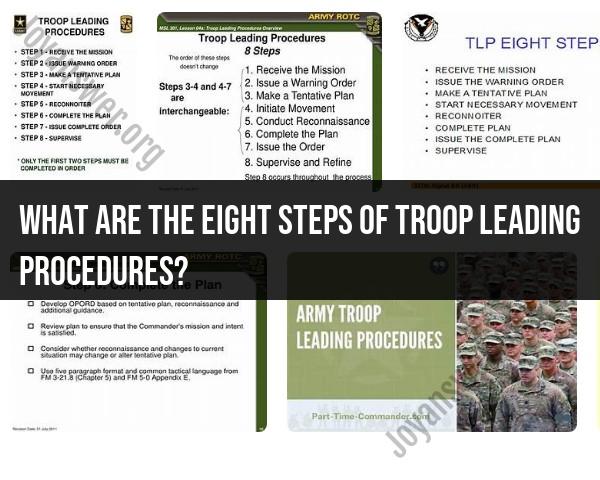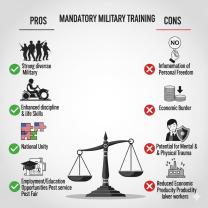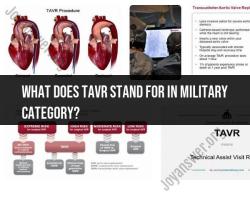What are the eight steps of Troop Leading Procedures?
Troop Leading Procedures (TLP) are a systematic, flexible planning process used by military leaders to analyze a mission, develop a plan, and prepare for execution. While specific terms and details may vary among military branches, the U.S. Army commonly uses an eight-step Troop Leading Procedures framework. Here are the eight essential steps:
1. Receive the Mission:
- The leader receives a clear, concise statement of the mission. This includes the who, what, when, where, and why of the task at hand.
2. Issue a Warning Order:
- The leader issues a preliminary warning order to inform subordinates that a mission is forthcoming. This allows subordinates to begin their own mental and initial preparation.
3. Make a Tentative Plan:
- The leader makes a tentative plan based on the information received. This involves analyzing the mission, conducting a mission analysis, and developing a preliminary course of action (COA).
4. Initiate Movement:
- The leader initiates movement as soon as possible to conduct a reconnaissance and gather additional information. This step is crucial for obtaining a more accurate understanding of the terrain, enemy, and other factors that might affect the plan.
5. Conduct Reconnaissance:
- The leader conducts a reconnaissance to gather essential information about the terrain, enemy, and other relevant factors. This information is crucial for making informed decisions during the planning process.
6. Complete the Plan:
- The leader completes the plan based on the reconnaissance findings and additional information. This includes developing a detailed and feasible COA, coordinating resources, assigning tasks, and establishing timelines.
7. Issue the Order:
- The leader issues a clear and concise order to communicate the plan to subordinates. The order includes the commander's intent, concept of the operation, tasks for subordinates, coordinating instructions, and other relevant details.
8. Supervise and Refine:
- The leader supervises the execution of the plan, making necessary adjustments as the situation develops. This step involves continuous monitoring, communication, and adaptation to ensure the plan's success.
These eight Troop Leading Procedures provide a systematic and organized approach to mission planning and execution in military operations. By following these steps, leaders can enhance their ability to analyze complex situations, make informed decisions, and effectively lead their units in various scenarios.
What are the eight sequential steps involved in Troop Leading Procedures?
The eight sequential steps involved in Troop Leading Procedures (TLP) are:
- Receive the mission
The leader receives the mission from a higher authority, either through a written order, a briefing, or a verbal instruction. The leader should carefully analyze the mission to understand its purpose, intent, and desired end state. Any unclear aspects of the mission should be clarified with the higher authority.
- Issue a Warning Order (WARNO)
The WARNO is a brief, preliminary order that provides subordinate units with essential information about the upcoming mission. It typically includes the mission, time and location of the operation, enemy situation, and any other critical details. The WARNO helps subordinate leaders start planning and preparing for the mission, even before the complete details are available.
- Make a tentative plan
This step involves the leader developing a preliminary plan for accomplishing the mission. The plan should consider various factors, including the mission, enemy situation, terrain, available resources, and capabilities of the unit. The tentative plan is a working document and may be modified as more information becomes available.
- Initiate movement
This step involves the leader issuing the operations order (OPORD) and initiating movement of the unit to the assigned area. The OPORD is a detailed order that provides all necessary information for subordinate units to execute the mission. It includes the mission, enemy situation, friendly situation, concept of the operation, tasks for each unit, and timelines.
- Conduct reconnaissance
Reconnaissance involves gathering information about the enemy, terrain, and other relevant factors in the mission area. This information is crucial for updating the plan and making informed decisions during the operation. Reconnaissance can be conducted through various means, including patrols, observation posts, and intelligence reports.
- Issue supplements and fragmentary orders (FRAGOs)
Supplements and fragmentary orders (FRAGOs) are used to update the OPORD and provide additional instructions as needed. Supplements typically address changes in the situation that require adjustments to the plan. FRAGOs are used to assign specific tasks or missions to subordinate units during the operation.
- Supervise and refine
Supervision involves the leader monitoring the execution of the mission and ensuring that subordinate units are on track to accomplish their objectives. This includes conducting rehearsals, back briefs, and checking on the status of personnel and equipment. Refinement involves making adjustments to the plan as needed based on the unfolding situation.
- Relieve and report
This step involves relieving subordinate units from their assigned tasks and reporting the mission's completion or status to the higher authority. The report should include information about the mission's accomplishment, any casualties or losses sustained, and any lessons learned.
These eight steps are a fundamental part of Troop Leading Procedures and provide a framework for leaders to plan, prepare, and execute military operations effectively. By following these steps and adapting them to specific situations, leaders can increase their chances of success and ensure the safety and well-being of their troops.
Here are some additional points to consider:
- The specific details of each step may vary depending on the type of mission, the size of the unit, and the available resources.
- Effective communication is essential throughout the TLP process.
- Leaders should be flexible and adaptable to changing circumstances.
- Continuous training and practice are crucial for improving proficiency in applying TLPs.
I hope this information is helpful!












